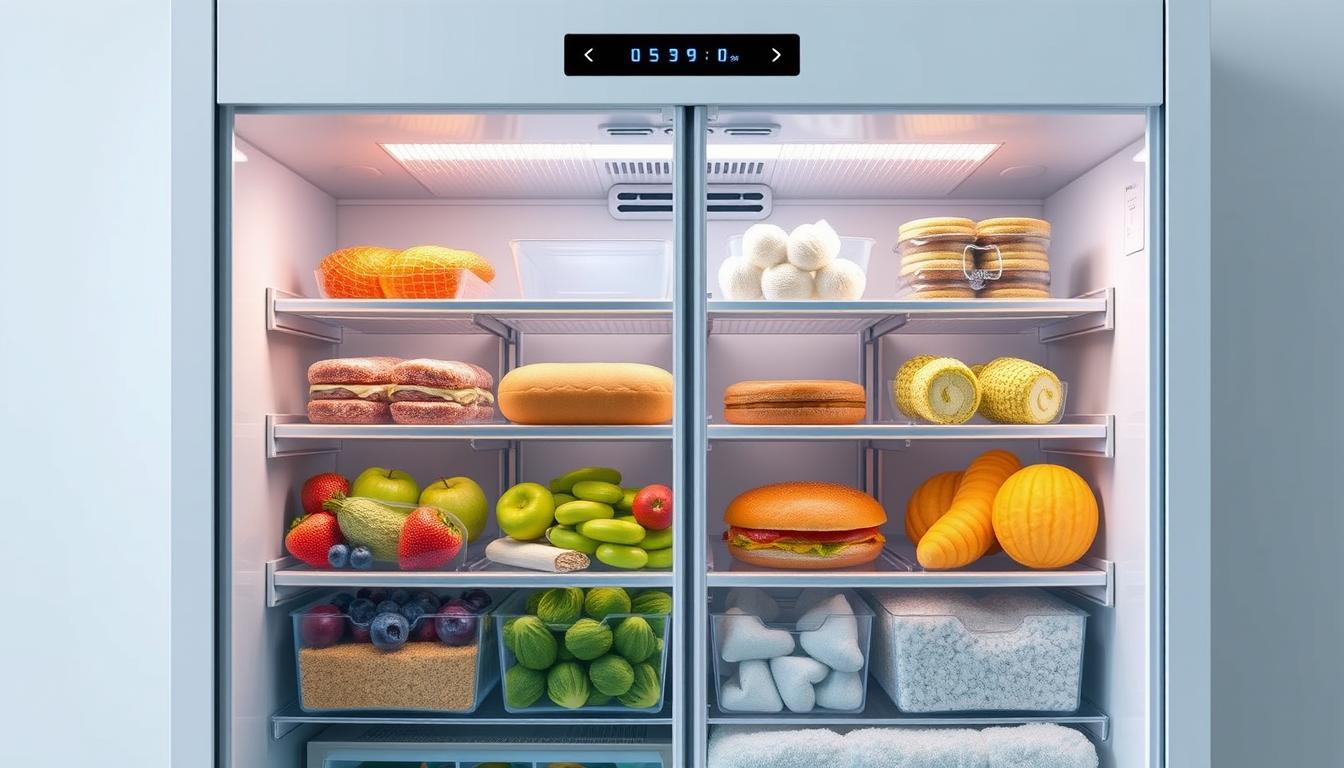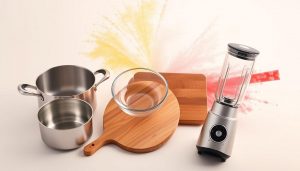Did you know that 42% of households with freezers still deal with ice buildup annually? Modern units now tackle this issue with automated systems that eliminate manual scraping. Behind their sleek designs lies a hidden cycle: heaters and fans activate every 6–8 hours to melt frost and circulate dry air, keeping your frozen goods intact.
Choosing between frost-free and traditional models isn’t just about convenience. While these appliances save you hours of defrosting, they use slightly more energy. You’ll also notice a higher upfront cost compared to manual options. But for busy homes, the trade-off often makes sense.
Your decision hinges on priorities. Do you value time-saving features or lower long-term costs? Consider how often you access your unit and what you store. Newer models have improved efficiency, but older versions might struggle with temperature consistency during defrost cycles.
Key Takeaways
- Automated systems prevent ice buildup using timed heating and cooling processes
- Energy use increases slightly compared to manual defrost units
- Higher initial cost balances against long-term convenience
- Modern designs minimize temperature fluctuations during maintenance cycles
- Household size and usage frequency determine ideal freezer type
Understanding Frost-Free Freezers: What They Are
Ever opened your appliance to find stubborn ice layers clinging to shelves? Modern solutions tackle this issue through smart engineering. These units manage frost buildup automatically, letting you focus on storing food rather than scraping walls.

How Frost-Free Technology Works
A hidden heating element activates every 6–8 hours, melting frost before it accumulates. The fan then pushes dry, cold air across surfaces, preventing moisture from reforming as ice. This system runs briefly—usually 25–45 minutes—without disrupting your frozen goods.
Safety mechanisms ensure precision. A thermostat monitors temperatures, shutting off the heater if levels rise too high. Whether using time-based or usage-based cycles, the process remains invisible to users.
Differences Between Frost-Free and Manual Defrost Models
Traditional units demand quarterly maintenance: unplugging, emptying, and waiting hours for ice to thaw. Frost-free versions eliminate this chore entirely. While manual models cost less upfront, they require more effort over time.
Temperature stability also varies. Standard freezers fluctuate during defrosting, risking food quality. Automated systems maintain steadier conditions, thanks to controlled air circulation. Energy use differs slightly, with frost-free designs consuming marginally more power during cycles.
The Design and Components of Frost-Free Freezers
Modern frost-free systems rely on three core components working in harmony. These elements prevent ice accumulation while maintaining stable storage conditions. Let’s explore how each piece contributes to seamless operation.

Key Elements: Door Seal, Fan, and Heating Element
Your freezer’s door seal acts as the first defense against humidity. A compromised gasket lets warm air seep in, forcing the cooling system to work harder. Wipe it monthly with mild soap to maintain flexibility.
The internal fan circulates chilled air evenly across shelves. This prevents warm spots near the door or back wall. If you hear unusual noises, check for obstructions around the blades.
During defrost cycles, a hidden heating element melts ice buildup. A safety thermostat stops the process if temperatures rise beyond safe limits. This prevents damage to frozen items while clearing drainage paths.
Innovative Design for Enhanced Efficiency
Advanced models now include drain heaters to stop ice blockages in water channels. These features work with angled vents that guide airflow precisely. The result? Faster recovery after door openings.
Manufacturers use durable polymers for seals and corrosion-resistant metals for coils. These materials extend your unit’s lifespan while reducing energy use. You’ll notice fewer temperature swings compared to older designs.
Strategic placement of sensors ensures components activate only when needed. This smart coordination between parts keeps your food preserved optimally without manual adjustments.
The Convenience Factor: Gone are Manual Defrosting
Imagine reclaiming entire afternoons previously lost to ice pick battles. Modern appliances handle frost removal through automated cycles, transforming a half-day chore into a forgotten memory. This innovation lets you prioritize life’s moments over appliance maintenance.
Time-Saving Benefits
Traditional units demand 4-6 hours quarterly for defrosting – emptying shelves, relocating food, and monitoring meltwater. With automated systems, you gain back 18-24 hours yearly that would otherwise vanish. No more rearranging meal plans around defrost days or begging neighbors for freezer space.

Simplified Maintenance Routine
Your upkeep tasks shrink to occasional wipe-downs with mild detergent. The table below contrasts maintenance demands:
| Task | Manual Defrosting | Frost-Free |
|---|---|---|
| Defrosting Frequency | Every 3 months | Never |
| Time Required | 4-6 hours | 0 hours |
| Temporary Storage | Required | Unnecessary |
| Maintenance Tasks | Scraping, drying | Surface cleaning |
This streamlined approach reduces household stress while protecting frozen goods from temperature swings during maintenance. You maintain food quality without calendar reminders for ice removal.
Enhanced Temperature Consistency and Storage Organization
Optimal freezing conditions transform how you store and access your food. Modern units maintain near-identical temperatures across shelves through advanced airflow systems. This precision prevents quality loss while maximizing every cubic inch of storage capacity.

Optimal Temperature Settings for Quality Preservation
Set your appliance to 0°F (-18°C) for ideal food preservation. Internal fans create uniform conditions, keeping variations under 3°F. In manual units, differences can exceed 20°F – risking partial thawing near the door.
At medium settings (3.5/7), frost-free models achieve perfect balance. Shelves stay between 22-25°F, regardless of placement. This stability protects delicate items like ice cream from crystal formation.
| Feature | Frost-Free | Manual Defrost |
|---|---|---|
| Temp Variation | ±3°F | ±20°F |
| Usable Space | 97% | 70% |
| Organization Ease | Unobstructed shelves | Ice-blocked areas |
| Energy Use | Stable | Spikes during defrost |
Without ice buildup, you gain 30% more space for meal prep containers or bulk purchases. Clear bins stack neatly since frost doesn’t weld them to surfaces.
Labeling systems work better when shelves remain accessible. You’ll locate items quickly without chipping through icy barriers. Consistent temperatures also mean frozen goods last longer – no more mystery meats hiding in cold pockets.
Frost-Free Freezers: A Cooling Conundrum – Balancing Benefits and Drawbacks
When selecting kitchen appliances, you face critical decisions between upfront investments and long-term gains. Modern refrigeration options present this dilemma clearly, requiring careful evaluation of their trade-offs.
Evaluating the Pros and Cons
Automated units typically cost 15-25% more than manual alternatives. This price difference reflects advanced engineering that eliminates ice scraping. While daily energy use is slightly higher, traditional models lose efficiency as frost accumulates, forcing them to work harder.

Newer models offset energy demands with precision insulation and airflow systems. You gain time normally spent defrosting – up to 30 hours yearly for frequent users. Temperature consistency also improves, reducing freezer burn risks.
Weighing Cost Versus Convenience
Your choice hinges on lifestyle priorities. Busy households often find the convenience advantage outweighs initial costs. Consider this comparison:
- Upfront expense: Higher investment for automated units
- Long-term value: Saved maintenance time and food preservation benefits
- Energy trade-off: Slight usage increase vs frost-induced inefficiency
For families storing bulk items or delicate foods, advanced temperature controls justify the price gap. Those with infrequent freezer use might prefer manual models. Your decision ultimately reflects how much you value time versus upfront savings.
Energy Efficiency Considerations and Electricity Use
How much extra power does automated frost prevention really consume? Modern units balance daily energy demands with long-term performance gains. The secret lies in optimized components that work smarter, not harder.
Comparing Energy Consumption with Manual Defrost Models
Automated systems use 5-10% more electricity daily for defrost cycles and air circulation. But this gap shrinks as ice accumulates in manual units. Thick frost layers act like insulation, forcing compressors to run 30% longer.
Newer models minimize spikes with precision. Fans draw just 0.03 amps while moving 6 cubic feet of air per minute. Variable-speed compressors adjust output based on real-time needs rather than fixed intervals.
Long-term Financial Impact of Energy Use
Your yearly costs might surprise you. While frost-free units have higher baseline consumption, they avoid the efficiency drops manual models experience. A 2023 study showed automated systems save $15-40 annually once ice buildup exceeds ¼ inch.
Key factors tilt the scales:
- Smart defrost timing prevents unnecessary energy use
- Enhanced insulation reduces compressor duty cycles
- Efficient fans maintain airflow without power drains
Over a 10-year lifespan, the total cost difference often falls below $200. For households valuing time and consistent performance, this premium buys freedom from icy maintenance chores.
Impact on Food Quality and Freezer Burn
Ever pulled out frozen food only to find it covered in icy crystals? The same air circulation that prevents frost buildup can affect your stored items if not managed properly. Proper packaging becomes your best defense against quality loss.
Preventing Freezer Burn Effectively
Dry air movement helps maintain temperature consistency but draws moisture from exposed surfaces. Use airtight containers or vacuum-sealed bags for meats and leftovers. Remove excess air from freezer bags before sealing – this simple step preserves texture and flavor for months.
Ensuring Optimal Food Preservation
Label packages with dates and contents to track freshness. Stack items tightly to minimize air exposure between products. Glass containers with locking lids work particularly well for preventing freezer burn while allowing easy visibility.
While frost-free models excel at long-term storage, your vigilance with packaging determines success. Invest in quality storage solutions, and you’ll enjoy preserved flavors and nutrients without icy degradation.



